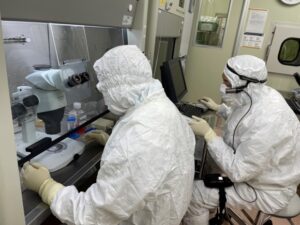| Nov 09, 2022 Successful establishment and development of efficient clinical human ES cell lines and banking of cell lines |
Kei Takada, Ryoko Nakatani, Emiko Moribe, Shizuka Yamazaki-Fujigaki, Mai Fujii, Masayo Furuta, Hirofumi Suemori, and Eihachiro Kawase*
Division of Clinical Basis for ES Cell Research, Center for Human ES Cell Research, Institute for Life and Medical Sciences, Kyoto University, 53 Kawahara-cho, Shogoin, Sakyo-ku, Kyoto 606-8507, Japan
Efficient derivation and banking of clinical-grade human embryonic stem cell lines in accordance with Japanese regulations
Regenerative Therapy (2022) 21, 553-559. doi.org/10.1016/j.reth.2022.10.006
Dr. Kawase’s team reported the efficient derivation and banking of clinical-grade human embryonic stem cell lines in accordance with Japanese regulations. We recently reported clinical-grade human embryonic stem cell (hESC) line KthES11 under current good manufacturing practice standards in Japan. Despite this success, the establishment efficiency was very low at 7.1% in the first period. To establish clinical-grade hESC lines, we used xeno-free chemically defined medium StemFit AK03N with the LM-E8 fragment instead of feeder cells. The protocol was then optimized, especially in the early culture phase. We established five hESC lines (KthES12, KthES13, KthES14, KthES15, and KthES16) with 45.5% efficiency. All five hESC lines showed typical hESC-like morphology, a normal karyotype, pluripotent state, and differentiation potential for all three germ layers. Furthermore, we developed efficient procedures to prepare master cell stocks for clinical-grade hESC lines and an efficient strategy for quality control testing. Our master cell stocks of hESC lines may contribute to therapeutic applications using human pluripotent stem cells in Japan and other countries.

Figure 1: Internal cell mass isolation in establishing human ES cell lines for clinical use.
(A) Internal cell mass (ICM) is separated from the blastocyst using a micromanipulator (↓) set up under a microscope. (B) Blastocyst used for establishment. The dotted line indicates the ICM. (C) Cleanly isolated ICM. (D) ICM on the day after culture. ICM was firmly attached to the culture substrate.

Figure 2: Culture operations during establishing human ES cells for clinical use in the cell processing room.
Aseptic manipulation was performed while checking the colonies of human ES cells under a stereomicroscope at the stage during which the number of cells was minimal. (Work is performed in a clean suit in a specially cleaned room to ensure safety.)
